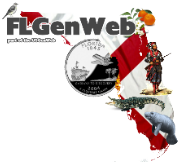
.png)
 ®
®

|
.png) |
 ® ® |
FLGenWeb State Coordinator: Jeff Kemp | Asst. State Coordinator: Tricia Aanderud County Coordinator: ADOPT ME! Home | Archives | Bibliography | Cemeteries | Census | Cities & Towns | History | Libraries Maps | Military | Vital Records | Volunteer |
|
|
|
from Wikipedia--
Fort established (1850s–1860s)After Florida became a U.S. territory in 1821, a number of settlers moved into Florida, causing conflict with the local Seminole Indians. Fort Myers was built in 1850 as a militar.0p,.y fort to fend off Seminole Indians during the Seminole Wars. The fort was named after Col. Abraham C. Myers, who was stationed in Florida for seven years and was the son-in-law of the fort's establisher and commander. In 1858, after years of elusive battle, Chief Billy Bowlegs and his warriors were persuaded to surrender and move west, and the fort was abandoned. Billy's Creek, which flows into the Caloosahatchee River, was named after a temporary camp where Billy Bowlegs and his men awaited ships to take them west. In 1863, the fort was reoccupied by federal troops during the Civil War. In 1865, in the Battle of Fort Myers, the fort was attacked by a small group of Confederates. The Union's garrison, led by Captain James Doyle, successfully held the fort and the Confederate forces retreated. After the war, the fort was again deserted. The fort was later disassembled and some of its wood was used to build parts of downtown Fort Myers. Settlement and early growth (1860s–1920s)The first settlers in Fort Myers arrived in 1866. In the 1870s, Tervio Padilla, a wealthy merchant from the Canary Islands, came by way of Key West to Cayo Costa and established trade with natives and "ranchos" that extended northward to Charlotte Harbor. His ships often made port at Cayo Costa at the entrance to the harbor. Enchanted by the tropical island, he eventually decided to settle there. Padilla prospered until the outbreak of the Spanish–American War, when his fleet was burned and scuttled. He then turned to another means of livelihood – fishing. When the government claimed his land, he was disinclined to set up another ranch, so moved with his wife further down the island and as before, simply homesteaded . The Padilla family is one of the first pioneer families of Lee County and many still reside within the county mainly around the Pine Island area. In 1882, the city experienced a significant influx of settlers. By 1885, when Fort Myers was incorporated, its population of 349 residents made it the second-largest city only to Tampa on Florida's west coast south of Cedar Key, even larger than Clearwater and Sarasota, also growing cities at the time. The city of Fort Myers was incorporated in 1886. Lee County was created in 1887 from Monroe County. It was named for Robert E. Lee, Confederate general in the American Civil War. Fort Myers first became a nationally known winter resort with the opening of the Royal Palm Hotel in 1898, built by New York City department store magnate Hugh O'Neill. Fort Myers was the frequent winter home of Thomas Edison, as well as Henry Ford. Construction of the Tamiami Trail Bridge, built across the Caloosahatchee River in 1924, sparked the city's growth. After the bridge's construction, the city experienced its first real estate boom and many subdivisions sprouted around the city. In 1923, Collier and Hendry Counties were created by splitting these areas from Lee County. |
||||||||||
(c) 1996 - Present | Last Updated 2023
banner created and courtesy of Jeff Kemp